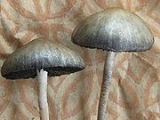
Panaeolus castaneifolius
Encyclopedia
Panaeolus olivaceus is a semi-rare and widely distributed little brown mushroom which contains the hallucinogen psilocybin
, is often mistaken for Panaeolina foenisecii
, and is distinguished by its black spore print and darker gill coloration when mature, as well as a slightly thicker stem. It is even more easily mistaken for Panaeolus cinctulus and can be distinguished from that species by its more campanulate cap shape when young and slightly roughened spores. It is also easily confused with Panaeolina castaneifolia
, a species which has spores that are dark brown and significantly more roughened.
, Georgia
, Canada
's Quebec
and in the United Kingdom
.

Psilocybin
Psilocybin is a naturally occurring psychedelic prodrug, with mind-altering effects similar to those of LSD and mescaline, after it is converted to psilocin. The effects can include altered thinking processes, perceptual distortions, an altered sense of time, and spiritual experiences, as well as...
, is often mistaken for Panaeolina foenisecii
Panaeolina foenisecii
Panaeolina foenisecii, commonly called the mower's mushroom, haymaker or brown hay mushroom, is a very common and widely distributed little brown mushroom often found on lawns. It fruits in warm weather and contains the hallucinogen psilocybin...
, and is distinguished by its black spore print and darker gill coloration when mature, as well as a slightly thicker stem. It is even more easily mistaken for Panaeolus cinctulus and can be distinguished from that species by its more campanulate cap shape when young and slightly roughened spores. It is also easily confused with Panaeolina castaneifolia
Panaeolina castaneifolia
Panaeolina castaneifolia is a rare and widely distributed little brown mushroom which may contain the hallucinogen psilocybin.It has dark brown, coarsely roughened spores which resemble those of Panaeolina foenisecii.- Description :...
, a species which has spores that are dark brown and significantly more roughened.
Description
- Cap: 1— 3(4) cm across, Distinctly campanulate then subhemispheric to convex, becoming broadly conic, not fully expanding, incurved margin when young, dark smoky-grayish to dark cinnamon, drying to a straw-yellow or slightly olive-gray color, remaining more reddish-brown towards the center, hygrophanous, smooth, sometimes striated or finely corrugated, flesh thick and firm.
- Gills: Adnate to adnexed, close, thin, pallid, mottled, slightly olive-greenish, becoming dark purplish gray-black in age, edge whitish.
- Stipe: 4— 6(7.5) cm by 3— 4(6) mm thick, equal to slightly tapering at the base, hollow, brittle, pruinose and slightly striate, no veil remnants. Grayish to ochraceous or tan at the base.
- Spores: Black, slightly roughened, 12 — 15(17) x 7 — 8.5(10) micrometers, elliptic, rugose or verrucose.
- Microscopic features: Basidia 24 — 28 x 10 - 12 micrometers. Cheilocystidia (20)24— 30(38) x (5)7 — 10 micrometers, abundant, neck often flexuous and apices usually obtuse, thin walled and hyaline, pleurocystidia rare or absent, not projecting beyond plane of basidia.
Habitat and formation
Panaeolus olivaceus grows scattered to gregariously in rich grassy areas, from late summer through December, across North and South America, likely more widely distributed; it has been collected in the U.S. states of Washington, OregonOregon
Oregon is a state in the Pacific Northwest region of the United States. It is located on the Pacific coast, with Washington to the north, California to the south, Nevada on the southeast and Idaho to the east. The Columbia and Snake rivers delineate much of Oregon's northern and eastern...
, Georgia
Georgia (U.S. state)
Georgia is a state located in the southeastern United States. It was established in 1732, the last of the original Thirteen Colonies. The state is named after King George II of Great Britain. Georgia was the fourth state to ratify the United States Constitution, on January 2, 1788...
, Canada
Canada
Canada is a North American country consisting of ten provinces and three territories. Located in the northern part of the continent, it extends from the Atlantic Ocean in the east to the Pacific Ocean in the west, and northward into the Arctic Ocean...
's Quebec
Quebec
Quebec or is a province in east-central Canada. It is the only Canadian province with a predominantly French-speaking population and the only one whose sole official language is French at the provincial level....
and in the United Kingdom
United Kingdom
The United Kingdom of Great Britain and Northern IrelandIn the United Kingdom and Dependencies, other languages have been officially recognised as legitimate autochthonous languages under the European Charter for Regional or Minority Languages...
.


